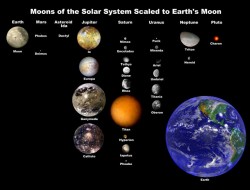The Earth has a single moon, while Saturn has more than 60, with new moons being discovered all the time. But here’s a question, can a moon have a moon? Can that moon’s moon have its own moon? Can it be moons all the way down?
First, consider that we have a completely subjective idea of what a moon is. The Moon orbits the Earth, and the Earth orbits the Sun, and the Sun orbits the center of the Milky Way, which orbits within the Local Group, which is a part of the Virgo Supercluster. The motions of objects in the cosmos act like a set of Russian nesting dolls, with things orbiting things, which orbit other things. So maybe a better question is: could any of the moons in the Solar System have moons of their own? Well actually, one does.
Right now, NASA’s Lunar Reconnaissance Orbiter is happily orbiting around the Moon, photographing the place in high resolution. But humans sent it to the Moon, and just like all the artificial satellites sent there in the past, it’s doomed. No satellite we’ve sent to the Moon has ever orbited for longer than a few years before crashing down into the lunar surface. In theory, you could probably get a satellite to last a few hundred years around the Moon.
But why? How come we can’t make moons for our moon to have a moon of it’s own for all time? It all comes down to gravity and tidal forces. Every object in the Universe is surrounded by an invisible sphere of gravity. Anything within this volume, which astronomers call the “Hill Sphere”, will tend to orbit the object.
So, if you had the Moon out in the middle of space, without any interactions, it could easily have multiple moons orbiting around it. But you get problems when you have these overlapping spheres of influence. The strength of gravity from the Earth tangles with the force of gravity from the Moon.

Although a spacecraft can orbit the Moon for a while, it’s just not stable. The tidal forces will cause the spacecraft’s orbit to decay until it crashes. But further out in the Solar System, there are tiny asteroids with even tinier moons. This is possible because they’re so far away from the Sun. Bring these asteroids closer to the Sun, and someone’s losing a moon.
The object with the largest Hill Sphere in the Solar System is Neptune. Because it’s so far away from the Sun, and it’s so massive, it can truly influence its environment. You could imagine a massive moon distantly orbiting Neptune, and around that moon, there could be a moon of its own. But this doesn’t appear to be the case.
NASA is considering a mission to capture an asteroid and put it into orbit around the Moon. This would be safer than having it orbit the Earth, but still keep it close enough to extract resources. But without any kind of orbital boost, those tidal forces will eventually crash it onto the Moon. So no, in our Solar System, we don’t know of any moons with moons of their own. In fact, we don’t even have a name for them. What would you suggest?


So what about when your moon is (about) the same size as your planet? Twin planets orbiting a shared center of gravity … is this possible?
The centre of gravity will lie outside either body if the bodies are approximately equal in weight (Pluto-Charon) or widely separated (Sun-Jupiter).
There is a nice diagram of the Sun’s motion in…
http://en.wikipedia.org/wiki/Barycentric_coordinates_%28astronomy%29
Yes, in fact we live in such a system. The Earth and Luna, our own moon share a common center of gravity. It’s inside the Earth, but not in the center. This causes the pair to wobble on their orbit around the sun.
Ah good point. Of course we do…
In a very broad sense of the word orbiting …
Jupiter’s Janus & Epimetheus might be considered as a moon orbiting a moon but on a very long elongated elliptical path.
No doubt a graph could be made removing Jupiter’s gravity well showing the two moons to co-orbit a central point of gravity with a normal circular orbits, although in figure 8 style.
There was talk a while ago about Saturn’s moon Rhea possibly having a ring system. Sadly, that turned out not to be true.